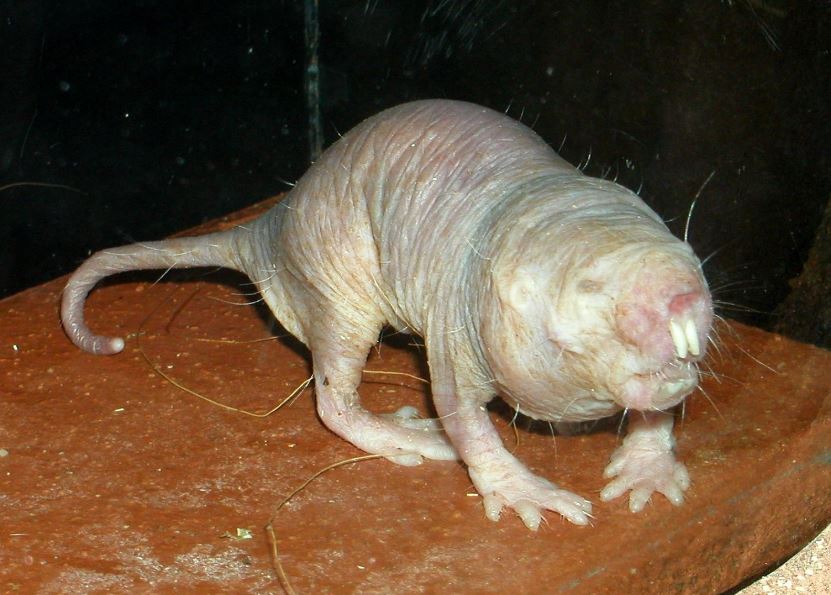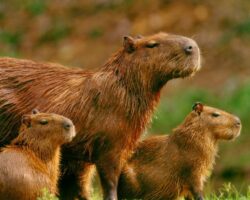When you look at the small size of moles, you may see it as a rodent. Moles are small mammals known to live underground. They are skillful diggers and can dig deep tunnels beneath the earth’s surface.
Moles are common in most parts of the world. They can be seen in all continents except Antarctica. It will be interesting to learn about these unique mammals called moles. In this article, we will uncover some facts about rodents and then know whether moles are rodents.
What is a Rodent and How Do You Identify One?
Rodents are special animals that are found in almost everything in the world. The Rodentia order contains more than 2,000 rodent species, making it the biggest order of mammals in the world.
Rodents typically have short limbs, long tails, and stocky bodies. These mammals live in different habitats, including savannas, rainforests, swamps, grasslands, and deserts.
Most rodents are herbivores, meaning they consume a lot of plants, grasses, and vegetables. However, some rodents are omnivores and can feed on insects and other small animals.
The main characteristic of rodents is their dentition. Rodents are known to have a set of incisors in their mouths. Virtually all rodents have a set of large, sharp incisor teeth that constantly grow throughout their lifetime.
Rodent teeth are incredibly sharp and powerful and can be used to chew and tear down most objects. Their teeth are sharp because of what they are made of. Surprisingly, a lot of rodents have a set of orange teeth, but this isn’t because of any tooth decay or disease.
Rather, their teeth are orange in color because they contain iron compounds. These compounds strengthen the teeth, make them durable, and give them a rust-like orange color.
Furthermore, the teeth of most rodents are self-sharpening. These teeth move against each other as the animal chews and gnaws. Rodents spend a lot of time chewing on a range of objects, including plants, tree barks, wood, grasses, etc to prevent their teeth from growing beyond their mouth.
Once the teeth become too long for their mouths, then there is a problem. To prevent this, rodents gnaw various materials. When they chew on objects, the softer dentin located on the rear of their incisors wears away more quickly than the strong enamel at the front. This activity creates a sharp, chisel-shaped tooth.
When you think of rodents, you tend to remember animals like rats and mice. But these are not the only animals known to be rodents. Other animals that are rodents include squirrels, voles, guinea pigs, chinchillas, chipmunks, beavers, porcupines, squirrels, and capybaras.
Are Moles Rodents?

Moles are not rodents, they do not belong to the Rodentia order, so they are not related to rodents in any way. Their diet and lifestyle differ from that of rodents.
Moles are excellent diggers, they can dig up to 160 feet in one night. They live underground and can spend most of their time there.
Moles do not belong to the Rodentia order but are members of Eulipotyphla, which include animals like desmans, hedgehogs, moonrats, and shrews.
There are multiple variants of moles with over 42 species recorded worldwide. Also, all mole species belong to the Talpidae family group. Most members of the Talpidae family, including desmans and shrew moles have excellent digging ability.
Another characteristic of Talpidae family members is that they have fairly small eyes and poor vision. Also, they can be identified by their dark fur, cylindrical bodies, and tubular snouts.
While rodents have a set of incisors, moles have different teeth. Most mole species have up to 44 teeth in their mouth.
One of the numerous differences between moles and rodents is that they do not have the ever-growing teeth, which rodents have. Rather, they have long, sharp twelve incisors. Their upper incisors are larger than the lower incisors. Also, moles have canine teeth, which you can’t find in rodents.
You can find up to four canine teeth in the mouth of most moles. Their canine teeth are sharp and strong. Their lower canine are larger and sharper than the upper ones. Another distinguishing characteristic in moles is that they have dilambodont molar teeth which feature two V-shaped ridges on them.
Moles’ teeth are crucial for their diet and lifestyle. Their blade-like teeth help them cut and chew prey. Most rodents are herbivores but moles are not.
Moles’ diet consists of earthworms and other small insects. As moles spend time burrowing and digging through the soil, they stumble on earthworms and other small insects, which they prey on. Aside from earthworms, they can also eat spiders, beetles, larvae, slugs, snails, and grubs.
Moles have a voracious appetite and need to eat food in large quantities to sustain themselves. Surprisingly, these mammals can eat over 75% of their body weight daily.
Even when they are full, moles can store earthworms for later meals. They have a network of tunnels and burrows where they keep hundreds and even thousands of insects for future consumption.
Moles are underground creatures. They spend a lot of their time underground, digging and creating new networks of burrows and tunnels. These expert diggers are not foolish when spending lots of hours burrowing.
Apart from creating shelter for themselves, these mammals create tunnels to make a “worm trap” to ensnare and capture worms. These tunnels are incredibly helpful to moles. They do not need to hunt worms all the time as the worms can fall into the tunnel, where they will be caught and eaten by the moles.
Moles have a set of short but powerful front legs coupled with clawed front feet that feature extra thumbs that help them dig the earth.
You may wonder how moles survive underground as their oxygen levels reduce when they are in their tunnels. Moles can deal with low oxygen levels and can cope with much higher carbon dioxide levels than most animals in the wild.
Another unique feature of moles is that they can save and use oxygen efficiently by reusing the air that has been exhaled.
Like most rodents, moles are often considered to be pests. Despite this, they provide several benefits to the ecosystem. Moles aerate the soil and also fertilize it with different materials and nutrients.
Moles are often blamed for killing crop yield by eating plant roots but they are innocent of this since they aren’t herbivores. Instead, they eat the grubs and worms that feed on plant roots.
Top 10 Facts About Naked Mole-rats

if you think you know all about moles, you may be wrong. There are so many mole facts that are yet to be unveiled. Here, we will see some of the top facts about mole-rats:
1. They Weigh Less Than a Penny At Birth
Newborn mole-rats weigh less than one penny at the time of birth. They are eusocial mammals, as they live in large colonies, which have only one breeding female known as the queen.
The queen is the only mole-rat in the colony that can produce offspring. On average, a single litter can be anywhere around 12 to 28 pups.
2. They Are Protected By Soldiers
Every colony is guarded by soldiers, who block the entrance and prevent predators and other threats from entering the tunnel.
Many soldier mole-rats are stationed at the entrance of the tunnel to stop intruders and defend the colony. The biggest predators of moles are snakes.
Snakes can find their way into the colony and prey on vulnerable moles. Most times, their target is to eat the queen and they will wrestle with the soldiers to gain entry.
3. They Construct Large Tunnels
Moles live in large tunnels and most times, a colony’s tunnels can be as large as 2.5 miles long. These animals spend a lot of time digging and creating systems of tunnels underground.
Their underground tunnels feature several chambers and compartments for different activities such as eating, nesting, resting, and excreting. Also, these tunnels within the burrow are interconnected.
Unlike other mammals, mole-rats find it challenging to maintain a steady body temperature and sometimes can crowd or assemble to keep themselves warm.

Despite the temperature of their burrow, which averages around 86 degrees Fahrenheit, these mole-rats tend to huddle together to share warmth.
4. They Don’t Drink Water
It’s unbelievable that mole-rats do not drink water. Rather, they get hydrated from their plant-based diet. While underground, these animals eat the underground parts of plants, be it the root or tuber, and this is enough to keep them sustain them till the next meal.
5. Their Eat Their Feces
Mole-rats are coprophagous animals, meaning they eat their own poop. This trait is similar to rodents like capybaras, which re-ingest their feces to absorb and maximize the nutrients.
6. They Can Move Their Teeth Separately
Mole-rats have different teeth in their mouth but surprisingly, they can move and control each of their front teeth independently.
7. They Have Powerful Jaws
The mole-rats’ jaws make up a quarter of its muscle mass. They use their powerful jaws and large incisors to dig and cut deep through the soil and dirt.
They keep their lips closed behind their front teeth to prevent dirt from entering their mouth while digging and burrowing through the hard-packed soil.
8. They Have Different Vocalizations
Moles have different communication sounds and noises, which they use to pass messages to each other.
They can use hisses, squeaks, chants, chirps, and other sounds to communicate with each other, especially to alert themselves of a predator. Awesomely, they have up to 17 different vocalizations.
While these animals are blind or have poor eyesight, they have a strong sense of smell.
9. They Sleep Belly-up
This is another unique feature of mole-rats; they sleep on their backs, which is belly-up.
10. They Have a Long Lifespan
Most rodents and small animals, whether in captivity or in the wild live for only a few years but mole-rats can live more than three decades. This isn’t common to find in small rodents but moles can survive up to their 30s.
Conclusion
Despite their small size and appearance, moles are not rodents. While the Rodentia family features thousands of rodent species, the mole isn’t one of them.
There are up to 42 species of moles in all continents of the world, except Antarctica. Moles are unique mammals, they spend a lot of time digging and creating homes for themselves underground. Their teeth are rather different from what you find in the mouths of most rodents.
While moles aren’t rodents, they are Eulipotyphla members and also belong to the Talpidae family.






![Capybara Meat And Its Culinary Uses - [Every You Should Know] Capybara Meat & Culinary Uses](https://capybaratips.com/wp-content/uploads/2023/03/Capybara-meat-250x200.webp)


